MERCEDES-BENZ G-CLASS SUV 2008 Manual PDF
Manufacturer: MERCEDES-BENZ, Model Year: 2008, Model line: G-CLASS SUV, Model: MERCEDES-BENZ G-CLASS SUV 2008Pages: 293, PDF Size: 4.49 MB
Page 71 of 293
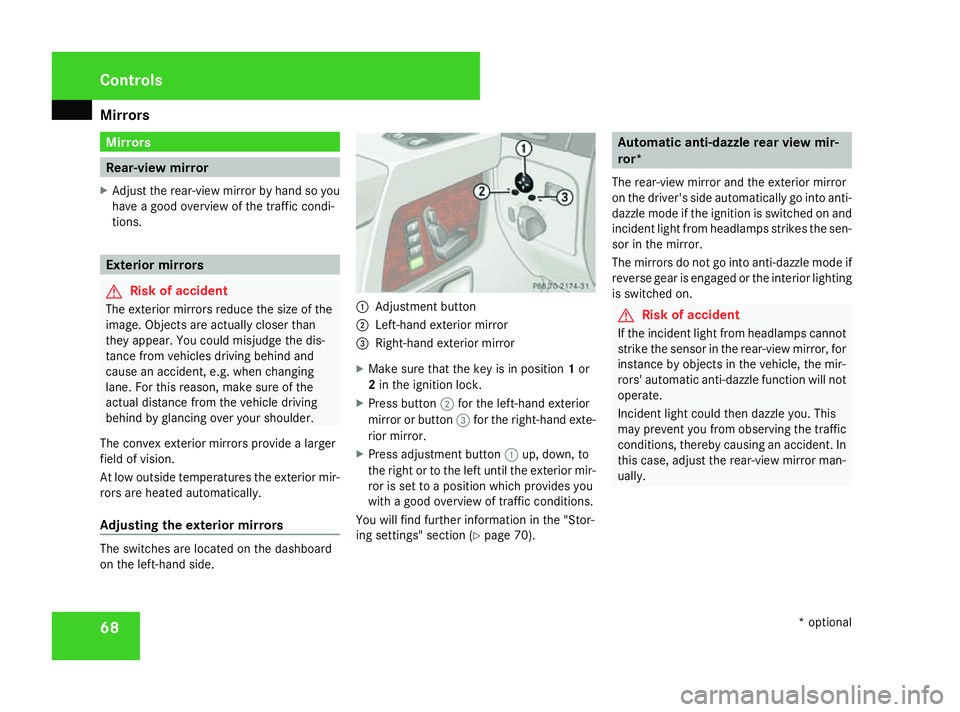
Mirrors
68 Mirrors
Rear-view mirror
X Adjust the rear-view mirror by hand so you
have a good overview of the traffic condi-
tions. Exterior mirrors
G
Risk of accident
The exterior mirrors reduce the size of the
image. Objects are actually closer than
they appear. You could misjudge the dis-
tance from vehicles driving behind and
cause an accident, e.g. when changing
lane. For this reason, make sure of the
actual distance from the vehicle driving
behind by glancing over your shoulder.
The convex exterior mirrors provide a larger
field of vision.
At low outside temperatures the exterior mir-
rors are heated automatically.
Adjusting the exterior mirrors The switches are located on the dashboard
on the left-hand side. 1
Adjustment button
2 Left-hand exterior mirror
3 Right-hand exterior mirror
X Make sure that the key is in position 1or
2 in the ignition lock.
X Press button 2for the left-hand exterior
mirror or button 3for the right-hand exte-
rior mirror.
X Press adjustment button 1up, down, to
the right or to the left until the exterior mir-
ror is set to a position which provides you
with a good overview of traffic conditions.
You will find further information in the "Stor-
ing settings" section (Y page 70). Automatic anti-dazzle rear view mir-
ror*
The rear-view mirror and the exterior mirror
on the driver's side automatically go into anti-
dazzle mode if the ignition is switched on and
incident light from headlamps strikes the sen-
sor in the mirror.
The mirrors do not go into anti-dazzle mode if
reverse gear is engaged or the interior lighting
is switched on. G
Risk of accident
If the incident light from headlamps cannot
strike the sensor in the rear-view mirror, for
instance by objects in the vehicle, the mir-
rors' automatic anti-dazzle function will not
operate.
Incident light could then dazzle you. This
may prevent you from observing the traffic
conditions, thereby causing an accident. In
this case, adjust the rear-view mirror man-
ually. Controls
* optional
463_AKB; 1; 8, en-GB
wobuchh,
Version: 2.10.6 2008-07-17T15:19:41+02:00 - Seite 68Dateiname: 6515_4091_02_buchblock.pdf; preflight
Page 72 of 293
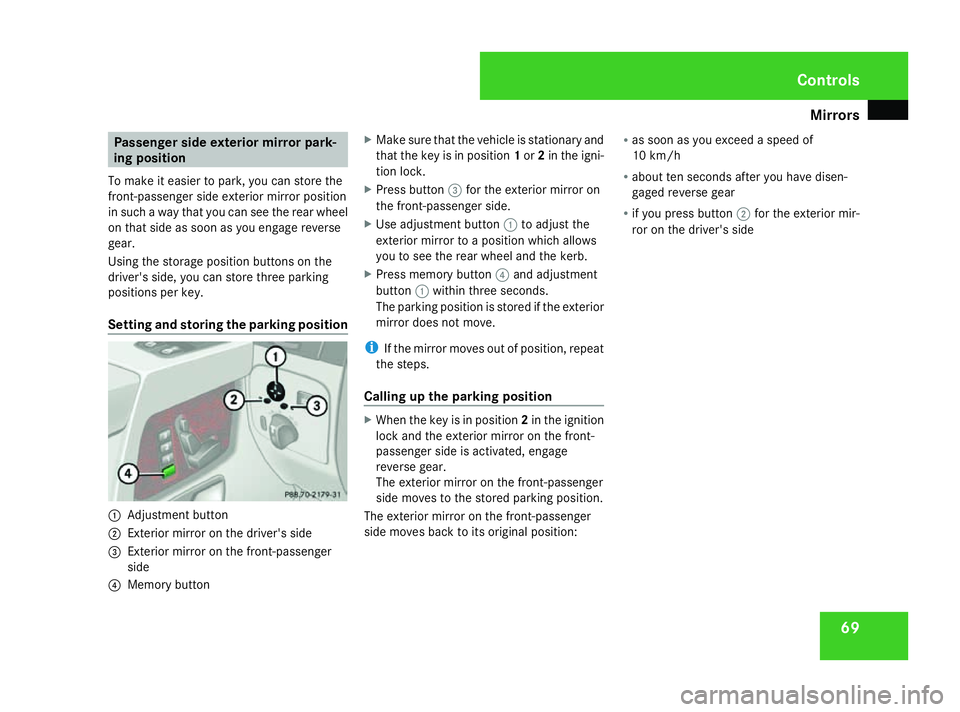
Mirrors
69Passenger side exterior mirror park-
ing position
To make it easier to park, you can store the
front-passenger side exterior mirror position
in such a way that you can see the rear wheel
on that side as soon as you engage reverse
gear.
Using the storage position buttons on the
driver's side, you can store three parking
positions per key.
Setting and storing the parking position 1
Adjustment button
2 Exterior mirror on the driver's side
3 Exterior mirror on the front-passenger
side
4 Memory button X
Make sure that the vehicle is stationary and
that the key is in position 1or 2in the igni-
tion lock.
X Press button 3for the exterior mirror on
the front-passenger side.
X Use adjustment button 1to adjust the
exterior mirror to a position which allows
you to see the rear wheel and the kerb.
X Press memory button 4and adjustment
button 1within three seconds.
The parking position is stored if the exterior
mirror does not move.
i If the mirror moves out of position, repeat
the steps.
Calling up the parking position X
When the key is in position 2in the ignition
lock and the exterior mirror on the front-
passenger side is activated, engage
reverse gear.
The exterior mirror on the front-passenger
side moves to the stored parking position.
The exterior mirror on the front-passenger
side moves back to its original position: R
as soon as you exceed a speed of
10 km/h
R about ten seconds after you have disen-
gaged reverse gear
R if you press button 2for the exterior mir-
ror on the driver's side Controls
463_AKB; 1; 8, en-GB
wobuchh,
Version: 2.10.6 2008-07-17T15:19:41+02:00 - Seite 69 ZDateiname: 6515_4091_02_buchblock.pdf; preflight
Page 73 of 293

Memory functions
70 Memory functions
Storing settings
Using the memory button on the driver's side
you can store up to three different settings
per key. You can store one setting per mem-
ory button on the front-passenger side.
On the driver's side the following settings can
be stored on each memory position:
R seat and head restraint position of the driv-
er's seat
R steering wheel position
R exterior mirror position on the driver’s and
front-passenger side
R parking position for the exterior mirror on
the front-passenger side
On the front-passenger side, the following
settings can be stored on each memory posi-
tion:
R seat and head restraint position of the
front-passenger seat G
Risk of accident
Only use the memory function on the driv-
er's side when the vehicle is stationary.
Otherwise, you could be distracted from
the traffic conditions by the steering wheel and seat moving of their own accord, as a
result cause an accident.
The buttons are located on the door control
panel. 1
Memory button
2 Storage position switches
X Make sure that the key is in position 2or
that the respective door is open.
X Adjust the seat and head restraint
(Y page 60).
X On the driver's side, also adjust the steer-
ing wheel (Y page 66) and the mirrors
(Y page 68). X
Press memory button 1.
X Press storage position switch 2within
three seconds.
The settings are stored in the selected stor-
age position. Calling up a stored setting
G
Risk of accident
Only use the memory function on the driv-
er's side when the vehicle is stationary.
Otherwise, you could be distracted from
the traffic conditions by the steering wheel
and seat moving of their own accord, as a
result cause an accident.
X Press the required storage position button
2 until the seat, head restraints, steering
wheel and mirrors are in the stored posi-
tion.
i The setting procedure is interrupted as
soon as you release the storage position
switch.
! If you want to move the seat from the fully
reclined position to a stored seat position,
first raise the backrest using the seat Controls
463_AKB; 1; 8, en-GB
wobuchh
, Version: 2.10.6 2008-07-17T15:19:41+02:00 - Seite 70Dateiname: 6515_4091_02_buchblock.pdf; preflight
Page 74 of 293
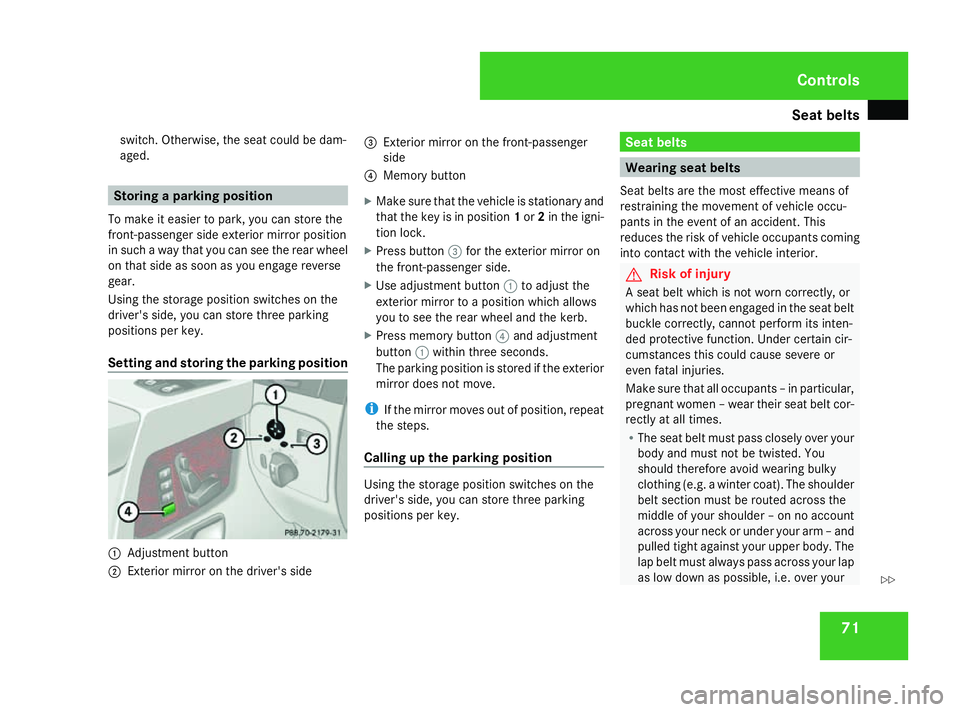
Seat belts
71
switch. Otherwise, the seat could be dam-
aged. Storing a parking position
To make it easier to park, you can store the
front-passenger side exterior mirror position
in such a way that you can see the rear wheel
on that side as soon as you engage reverse
gear.
Using the storage position switches on the
driver's side, you can store three parking
positions per key.
Setting and storing the parking position 1
Adjustment button
2 Exterior mirror on the driver's side 3
Exterior mirror on the front-passenger
side
4 Memory button
X Make sure that the vehicle is stationary and
that the key is in position 1or 2in the igni-
tion lock.
X Press button 3for the exterior mirror on
the front-passenger side.
X Use adjustment button 1to adjust the
exterior mirror to a position which allows
you to see the rear wheel and the kerb.
X Press memory button 4and adjustment
button 1within three seconds.
The parking position is stored if the exterior
mirror does not move.
i If the mirror moves out of position, repeat
the steps.
Calling up the parking position Using the storage position switches on the
driver's side, you can store three parking
positions per key. Seat belts
Wearing seat belts
Seat belts are the most effective means of
restraining the movement of vehicle occu-
pants in the event of an accident. This
reduces the risk of vehicle occupants coming
into contact with the vehicle interior. G
Risk of injury
A seat belt which is not worn correctly, or
which has not been engaged in the seat belt
buckle correctly, cannot perform its inten-
ded protective function. Under certain cir-
cumstances this could cause severe or
even fatal injuries.
Make sure that all occupants – in particular,
pregnant women – wear their seat belt cor-
rectly at all times.
R The seat belt must pass closely over your
body and must not be twisted. You
should therefore avoid wearing bulky
clothing (e.g. a winter coat). The shoulder
belt section must be routed across the
middle of your shoulder – on no account
across your neck or under your arm – and
pulled tight against your upper body. The
lap belt must always pass across your lap
as low down as possible, i.e. over your Controls
463_AKB; 1; 8, en-GB
wobuchh,
Version: 2.10.6 2008-07-17T15:19:41+02:00 - Seite 71 ZDateiname: 6515_4091_02_buchblock.pdf; preflight
Page 75 of 293

Seat belts
72 hip joints – not across your abdomen. If
necessary, push down the belt strap
slightly and then retighten it in the roll-up
direction.
R Do not route the belt strap across sharp
or fragile objects, especially if these are
located on or in your clothing, e.g. spec-
tacles, pencils, keys, etc. The seat belt
strap could be damaged and tear in an
accident and you or other vehicle occu-
pants could be injured.
R Only one person should use each seat
belt at any one time. Children must never
travel sitting on the lap of other occu-
pants. It would not be possible to restrain
the child in the event of a sudden change
in direction, braking or an accident. This
could result in severe or even fatal inju-
ries to the child and other occupants.
R Persons less than 1.50 m tall cannot
wear the seat belts correctly. For this
reason, secure persons less than 1.50 m
tall in specially designed, suitable
restraint systems.
R Children less than 1.50 m tall or under
12 years of age cannot wear the seat
belts properly. Therefore, always secure
these children in suitable child restraint systems on suitable vehicle seats. You
can find more information under "Chil-
dren in the vehicle" in the "Safety" sec-
tion of the Owner's Manual. Follow the
manufacturer's installation instructions
when fitting the child restraint system.
R Do not secure any objects with a seat belt
if the seat belt is also being used by one
of the vehicle's occupants. G
Risk of injury
The seat belt does not offer the intended
level of protection unless the backrest is
almost vertical. Under certain circumstan-
ces this could cause severe or even fatal
injuries.
Before starting a journey, make sure that
the seat is properly adjusted and that the
backrest is almost vertical. G
Risk of injury
A dirty or damaged seat belt or a seat belt
that has been subjected to a load in an
accident or modified no longer offers the
intended level of protection. Under certain
circumstances this could cause severe or
even fatal injuries. For this reason, check regularly that the
seat belts are not damaged or dirty.
Always have damaged seat belts or seat
belts that have been subjected to a load in
an accident replaced at a qualified special-
ist workshop. Choose a qualified specialist
workshop which has the necessary special-
ist knowledge and tools for the work
required. Mercedes-Benz recommends
that you use a Mercedes-Benz Service
Centre for this purpose.
For safety reasons, Mercedes-Benz recom-
mends that you only use seat belts which
have been approved by Mercedes-Benz for
your vehicle.Controls
463_AKB; 1; 8, en-GB
wobuchh,
Version: 2.10.6 2008-07-17T15:19:41+02:00 - Seite 72Dateiname: 6515_4091_02_buchblock.pdf; preflight
Page 76 of 293
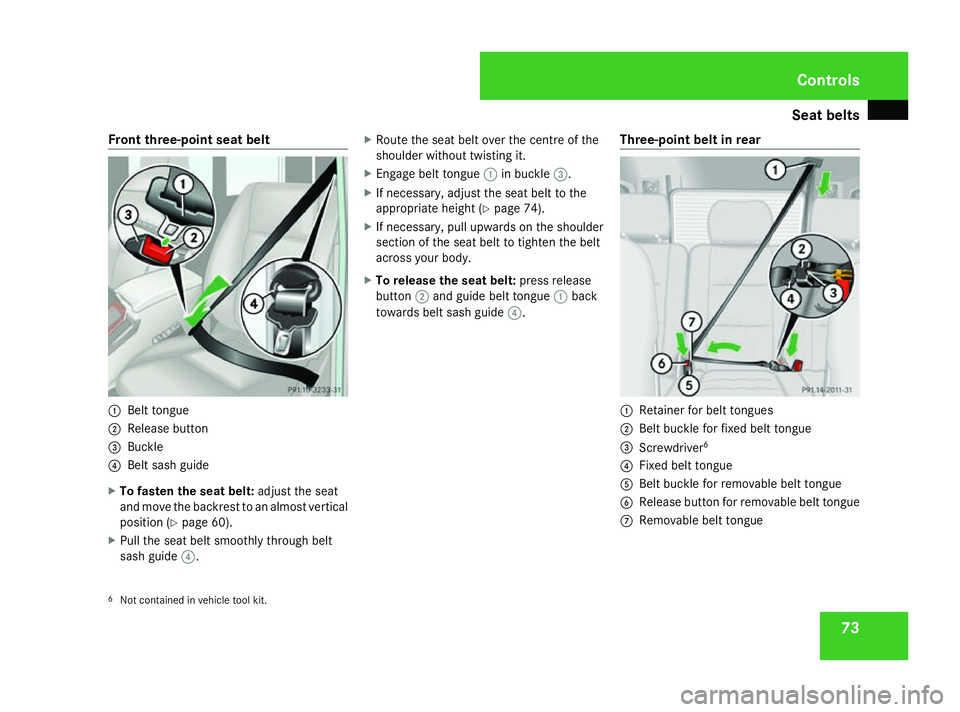
Seat belts
73
Front three-point seat belt
1
Belt tongue
2 Release button
3 Buckle
4 Belt sash guide
X To fasten the seat belt: adjust the seat
and move the backrest to an almost vertical
position (Y page 60).
X Pull the seat belt smoothly through belt
sash guide 4. X
Route the seat belt over the centre of the
shoulder without twisting it.
X Engage belt tongue 1in buckle 3.
X If necessary, adjust the seat belt to the
appropriate height (Y page 74).
X If necessary, pull upwards on the shoulder
section of the seat belt to tighten the belt
across your body.
X To release the seat belt: press release
button 2and guide belt tongue 1back
towards belt sash guide 4.Three-point belt in rear 1
Retainer for belt tongues
2 Belt buckle for fixed belt tongue
3 Screwdriver 6
4 Fixed belt tongue
5 Belt buckle for removable belt tongue
6 Release button for removable belt tongue
7 Removable belt tongue
6 Not contained in vehicle tool kit. Controls
463_AKB; 1; 8, en-GB
wobuchh,
Version: 2.10.6 2008-07-17T15:19:41+02:00 - Seite 73 ZDateiname: 6515_4091_02_buchblock.pdf; preflight
Page 77 of 293
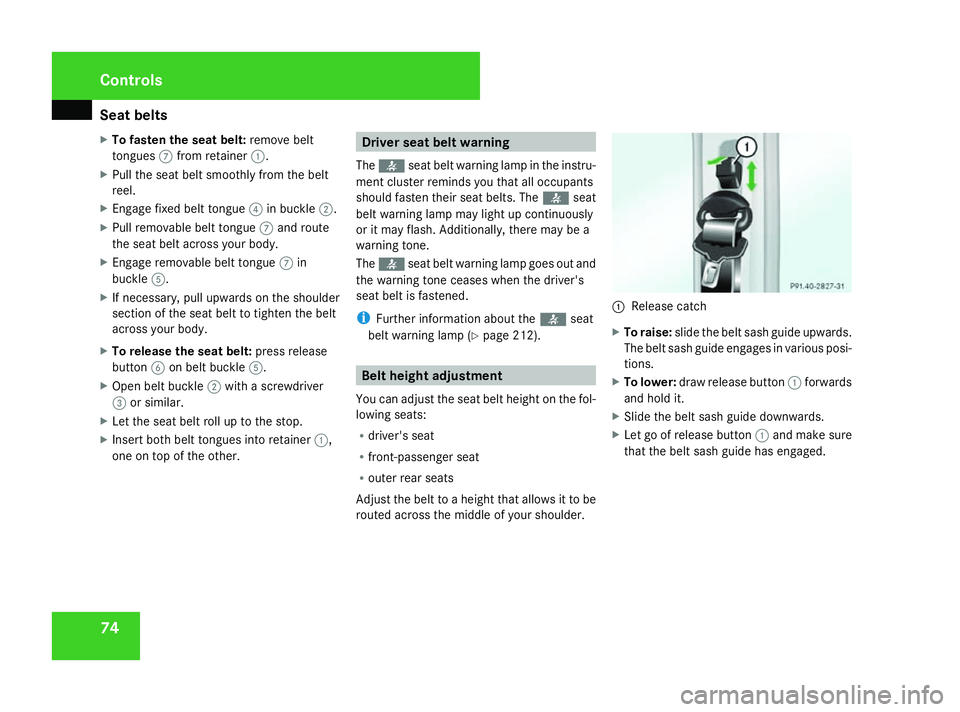
Seat belts
74
X
To fasten the seat belt: remove belt
tongues 7from retainer 1.
X Pull the seat belt smoothly from the belt
reel.
X Engage fixed belt tongue 4in buckle 2.
X Pull removable belt tongue 7and route
the seat belt across your body.
X Engage removable belt tongue 7in
buckle 5.
X If necessary, pull upwards on the shoulder
section of the seat belt to tighten the belt
across your body.
X To release the seat belt: press release
button 6on belt buckle 5.
X Open belt buckle 2with a screwdriver
3 or similar.
X Let the seat belt roll up to the stop.
X Insert both belt tongues into retainer 1,
one on top of the other. Driver seat belt warning
The < seat belt warning lamp in the instru-
ment cluster reminds you that all occupants
should fasten their seat belts. The
or it may flash. Additionally, there may be a
warning tone.
The < seat belt warning lamp goes out and
the warning tone ceases when the driver's
seat belt is fastened.
i Further information about the
You can adjust the seat belt height on the fol-
lowing seats:
R driver's seat
R front-passenger seat
R outer rear seats
Adjust the belt to a height that allows it to be
routed across the middle of your shoulder. 1
Release catch
X To raise: slide the belt sash guide upwards.
The belt sash guide engages in various posi-
tions.
X To lower: draw release button 1forwards
and hold it.
X Slide the belt sash guide downwards.
X Let go of release button 1and make sure
that the belt sash guide has engaged. Controls
463_AKB; 1; 8, en-GB
wobuchh,
Version: 2.10.6 2008-07-17T15:19:41+02:00 - Seite 74Dateiname: 6515_4091_02_buchblock.pdf; preflight
Page 78 of 293
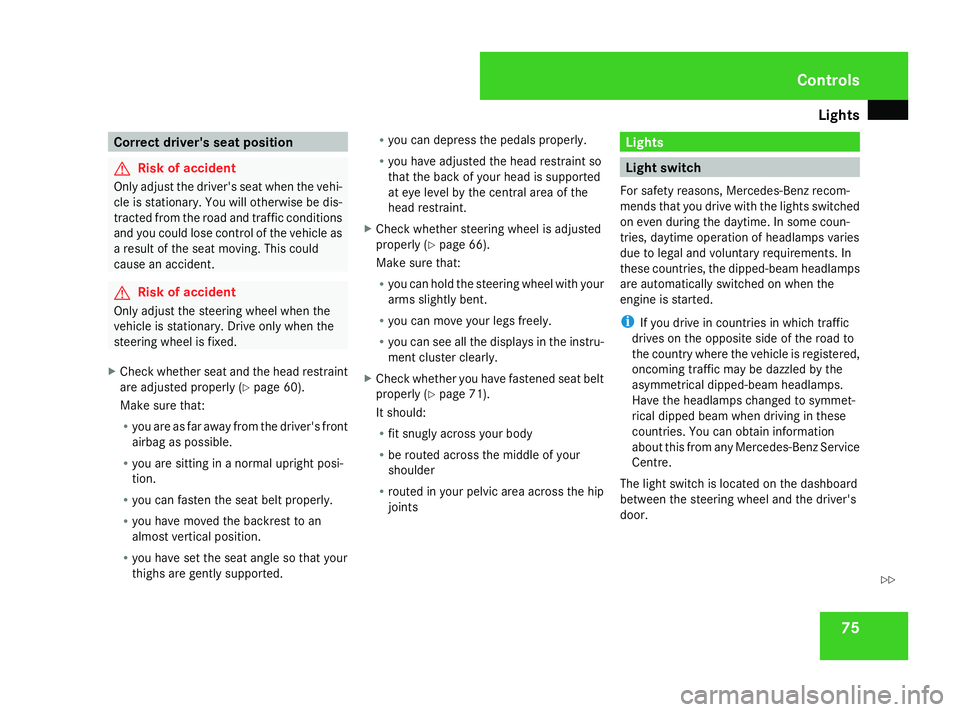
Lights
75Correct driver's seat position
G
Risk of accident
Only adjust the driver's seat when the vehi-
cle is stationary. You will otherwise be dis-
tracted from the road and traffic conditions
and you could lose control of the vehicle as
a result of the seat moving. This could
cause an accident. G
Risk of accident
Only adjust the steering wheel when the
vehicle is stationary. Drive only when the
steering wheel is fixed.
X Check whether seat and the head restraint
are adjusted properly (Y page 60).
Make sure that:
R you are as far away from the driver's front
airbag as possible.
R you are sitting in a normal upright posi-
tion.
R you can fasten the seat belt properly.
R you have moved the backrest to an
almost vertical position.
R you have set the seat angle so that your
thighs are gently supported. R
you can depress the pedals properly.
R you have adjusted the head restraint so
that the back of your head is supported
at eye level by the central area of the
head restraint.
X Check whether steering wheel is adjusted
properly (Y page 66).
Make sure that:
R you can hold the steering wheel with your
arms slightly bent.
R you can move your legs freely.
R you can see all the displays in the instru-
ment cluster clearly.
X Check whether you have fastened seat belt
properly (Y page 71).
It should:
R fit snugly across your body
R be routed across the middle of your
shoulder
R routed in your pelvic area across the hip
joints Lights
Light switch
For safety reasons, Mercedes-Benz recom-
mends that you drive with the lights switched
on even during the daytime. In some coun-
tries, daytime operation of headlamps varies
due to legal and voluntary requirements. In
these countries, the dipped-beam headlamps
are automatically switched on when the
engine is started.
i If you drive in countries in which traffic
drives on the opposite side of the road to
the country where the vehicle is registered,
oncoming traffic may be dazzled by the
asymmetrical dipped-beam headlamps.
Have the headlamps changed to symmet-
rical dipped beam when driving in these
countries. You can obtain information
about this from any Mercedes-Benz Service
Centre.
The light switch is located on the dashboard
between the steering wheel and the driver's
door. Controls
463_AKB; 1; 8, en-GB
wobuchh,
Version: 2.10.6 2008-07-17T15:19:41+02:00 - Seite 75 ZDateiname: 6515_4091_02_buchblock.pdf; preflight
Page 79 of 293
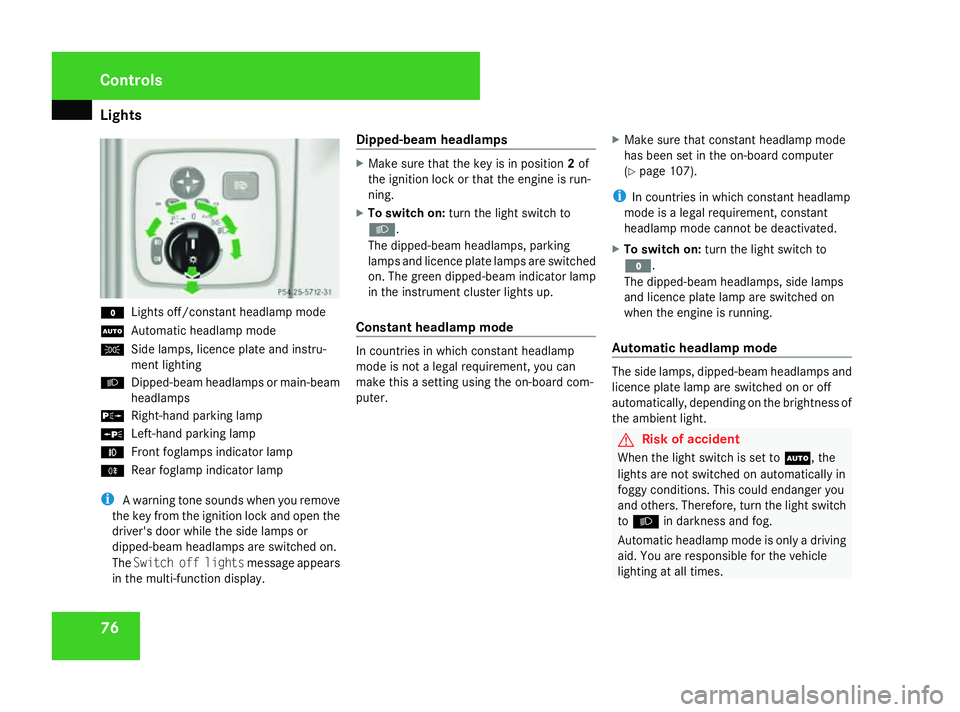
Lights
76M
Lights off/constant headlamp mode
U Automatic headlamp mode
C Side lamps, licence plate and instru-
ment lighting
B Dipped-beam headlamps or main-beam
headlamps
g Right-hand parking lamp
a Left-hand parking lamp
¥ Front foglamps indicator lamp
† Rear foglamp indicator lamp
i A warning tone sounds when you remove
the key from the ignition lock and open the
driver's door while the side lamps or
dipped-beam headlamps are switched on.
The Switch off lights message appears
in the multi-function display. Dipped-beam headlamps X
Make sure that the key is in position 2of
the ignition lock or that the engine is run-
ning.
X To switch on: turn the light switch to
B.
The dipped-beam headlamps, parking
lamps and licence plate lamps are switched
on. The green dipped-beam indicator lamp
in the instrument cluster lights up.
Constant headlamp mode In countries in which constant headlamp
mode is not a legal requirement, you can
make this a setting using the on-board com-
puter.
X
Make sure that constant headlamp mode
has been set in the on-board computer
(Y page 107).
i In countries in which constant headlamp
mode is a legal requirement, constant
headlamp mode cannot be deactivated.
X To switch on: turn the light switch to
M.
The dipped-beam headlamps, side lamps
and licence plate lamp are switched on
when the engine is running.
Automatic headlamp mode The side lamps, dipped-beam headlamps and
licence plate lamp are switched on or off
automatically, depending on the brightness of
the ambient light.
G
Risk of accident
When the light switch is set to U, the
lights are not switched on automatically in
foggy conditions. This could endanger you
and others. Therefore, turn the light switch
to B in darkness and fog.
Automatic headlamp mode is only a driving
aid. You are responsible for the vehicle
lighting at all times. Controls
463_AKB; 1; 8, en-GB
wobuchh,
Version: 2.10.6 2008-07-17T15:19:41+02:00 - Seite 76Dateiname: 6515_4091_02_buchblock.pdf; preflight
Page 80 of 293
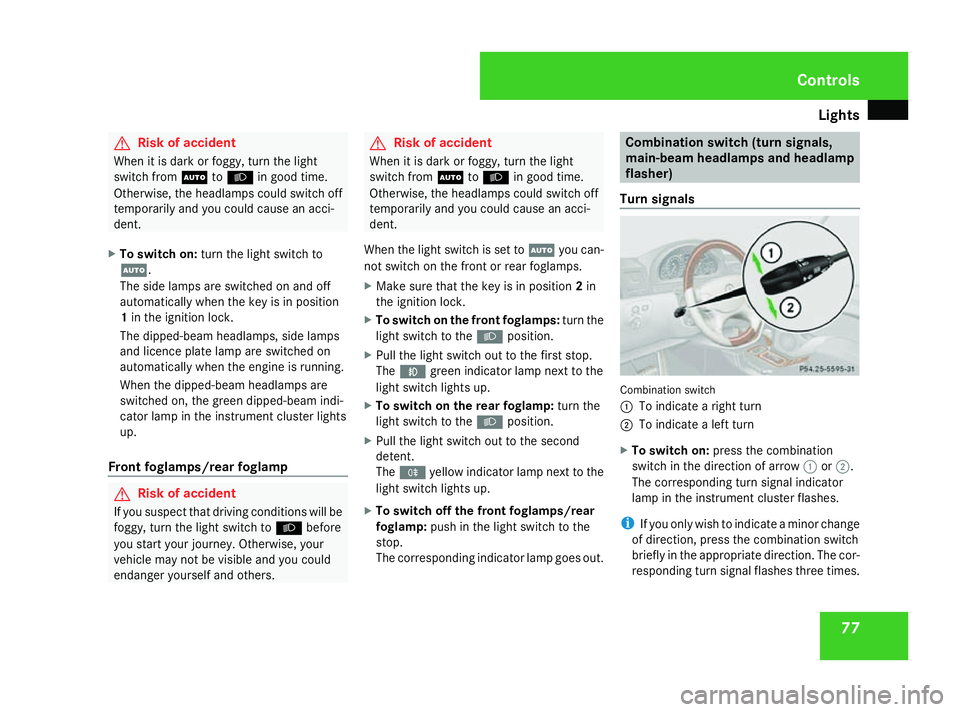
Lights
77G
Risk of accident
When it is dark or foggy, turn the light
switch from UtoB in good time.
Otherwise, the headlamps could switch off
temporarily and you could cause an acci-
dent.
X To switch on: turn the light switch to
U.
The side lamps are switched on and off
automatically when the key is in position
1 in the ignition lock.
The dipped-beam headlamps, side lamps
and licence plate lamp are switched on
automatically when the engine is running.
When the dipped-beam headlamps are
switched on, the green dipped-beam indi-
cator lamp in the instrument cluster lights
up.
Front foglamps/rear foglamp G
Risk of accident
If you suspect that driving conditions will be
foggy, turn the light switch to Bbefore
you start your journey. Otherwise, your
vehicle may not be visible and you could
endanger yourself and others. G
Risk of accident
When it is dark or foggy, turn the light
switch from UtoB in good time.
Otherwise, the headlamps could switch off
temporarily and you could cause an acci-
dent.
When the light switch is set to Uyou can-
not switch on the front or rear foglamps.
X Make sure that the key is in position 2in
the ignition lock.
X To switch on the front foglamps: turn the
light switch to the Bposition.
X Pull the light switch out to the first stop.
The ¥ green indicator lamp next to the
light switch lights up.
X To switch on the rear foglamp: turn the
light switch to the Bposition.
X Pull the light switch out to the second
detent.
The † yellow indicator lamp next to the
light switch lights up.
X To switch off the front foglamps/rear
foglamp: push in the light switch to the
stop.
The corresponding indicator lamp goes out. Combination switch (turn signals,
main-beam headlamps and headlamp
flasher)
Turn signals Combination switch
1
To indicate a right turn
2 To indicate a left turn
X To switch on: press the combination
switch in the direction of arrow 1or2.
The corresponding turn signal indicator
lamp in the instrument cluster flashes.
i If you only wish to indicate a minor change
of direction, press the combination switch
briefly in the appropriate direction. The cor-
responding turn signal flashes three times. Controls
463_AKB; 1; 8, en-GB
wobuchh,
Version: 2.10.6 2008-07-17T15:19:41+02:00 - Seite 77 ZDateiname: 6515_4091_02_buchblock.pdf; preflight